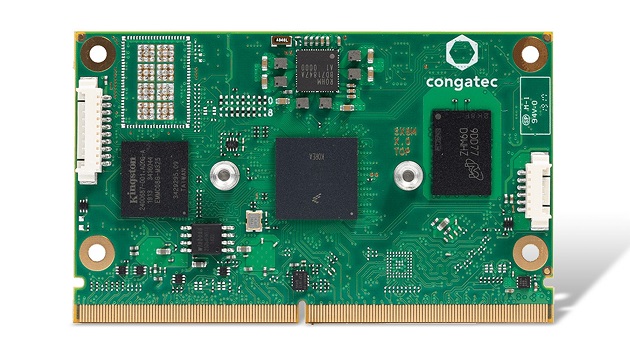Congatec, a leading vendor of standardized and customized embedded computer boards and modules introduces a new SMARC 2.0 Computer-on-Module with Arm Cortex-A53 based NXP Semiconductors i.MX 8M Nano processor. The conga-SMX8-Nano defines a new low-end performance class for SMARC. With its stunning ultra-low power graphics capabilities as well as its limited number of carefully selected I/Os, the new NXP i.MX 8M Mini compatible NXP i.MX 8M Nano processor targets low cost application areas not previously reached by – but perfectly suited for – vendor independent, standardized Computer-on-Modules.
Only up to 2 watt are needed for the logic of a mobile handheld device. Engineers can also turn a complex medical user interface with various mechanical buttons into an intuitive touch based and easy to use GUI or give industrial devices an interactive screen for which this was previously simply too expensive. All this, and even headless systems with IEEE 1588 Precision Time Protocol support for tactile IIoT, is now possible at the lowest power envelope and budget ever.
With the extensive ecosystem of SMARC Computer-on-Modules, engineers benefit from far more advanced and immediately ready to use components, standardized APIs and comprehensive BSPs. Another major plus point is the tremendous scalability, reaching way beyond the pin compatibility of NXP i.MX 8M Nano and Mini variants. Typical application areas are GUIs for edge devices which, if required, can also include voice assistance and voice controls. Vertical markets include wireless and networked medical and industrial equipment as well as home appliances and electronics, digital signage systems and mobile or outdoor devices, including smart city infrastructures such as small form factor digital bus time tables or headless platforms for edge gateways in smart cities as well as e-charging and free floating mobility devices.
“Application readiness and scalability are two major decisive factors for engineers to move to Arm based Computer-on-Modules. They want to come to market quickly, save NRE costs, and optimally balance the price and performance ratio for their low-cost high volume product families. With SMARC we offer them all these benefits off-the-shelf. They can scale application ready platforms within the entire i.MX 8 portfolio as well as beyond towards manifold different low-power application processors. This hardware agnostic benefit, with its inherent long-term availability, is another major reason why Arm application processor engineers increasingly rely on the proven design principles of standardized Computer-on-Modules,” explains Martin Danzer, Director Product Management at congatec.
The new NXP i.MX 8M Nano processor based SMARC modules are application ready subsystems that come with a comprehensive ecosystem including ready-to-go boot loader implementation, pre-qualified Linux, Yocto and Android BSPs, and fully featured evaluation carrier boards. congatec’s personal integration support and broad range of individually selectable technical services significantly simplify the integration of this new Arm based NXP processor for customers.
The feature set of the SMARC 2.0 modules
The new conga-SMX8-Nano SMARC Computer-on-Modules featuring the NXP i-MX 8M Nano processor are addressing ultra-low power and price-sensitive GUIs as well as headless industrial controls including IEEE 1588 Precision Time Protocol support for tactile IIoT. They are available in three variants with quad, dual or single core Arm Cortex-A53 processor, each variant seconded by 1 Cortex-M7. Each version is available for the extended (0°C to +60°C) and industrial (-40°C to +85°C) temperature range. The optional, processor integrated GC7000UltraLite 3D GPU supports 2x shader as well as OpenGL, OpenCL and Vulkan. Embedded displays can be connected via dual channel LVDS, eDP or MIPI-DSI. Up to 2 GByte of low-power LPDDR4 and an eMMC 5.1 non-volatile memory with up to 128 GByte provide extensive memory capacity on the module. Embedded cameras are connected via the MIPI-CSI-2 interface, while 4x USB 2.0 and 3x UART are state-of-the-art for industrial use. For intersystem connection, the module offers 1x Gbit Ethernet as well as optional M2 WiFi/Bluetooth extension.
Click here for more information









